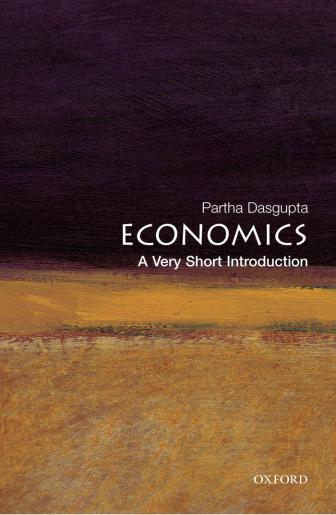
Oxford Economics A Very Short Introduction
.pdf
Economics: A Very Short Introduction

VERY SHORT INTRODUCTIONS are for anyone wanting a stimulating and accessible way in to a new subject. They are written by experts, and have been published in more than 25 languages worldwide.
The series began in 1995, and now represents a wide variety of topics in history, philosophy, religion, science, and the humanities. Over the next few years it will grow to a library of around 200 volumes – a Very Short Introduction to everything from ancient Egypt and Indian philosophy to conceptual art and cosmology.
Very Short Introductions available now:
ANARCHISM |
Colin Ward |
CHOICE THEORY |
|
||||
ANCIENT EGYPT |
Ian Shaw |
Michael Allingham |
|
||||
ANCIENT PHILOSOPHY |
CHRISTIAN ART |
Beth Williamson |
|||||
Julia Annas |
|
|
|
CHRISTIANITY Linda Woodhead |
|||
ANCIENT WARFARE |
CLASSICS |
Mary Beard and |
|||||
Harry Sidebottom |
John Henderson |
|
|||||
ANGLICANISM |
Mark Chapman |
CLAUSEWITZ |
Michael Howard |
||||
THE ANGLO-SAXON AGE |
THE COLD WAR |
Robert McMahon |
|||||
John Blair |
|
|
|
CONSCIOUSNESS |
Susan Blackmore |
||
ANIMAL RIGHTS |
David DeGrazia |
CONTEMPORARY ART |
|||||
ARCHAEOLOGY |
Paul Bahn |
Julian Stallabrass |
|
||||
ARCHITECTURE |
|
CONTINENTAL PHILOSOPHY |
|||||
Andrew Ballantyne |
Simon Critchley |
|
|||||
ARISTOTLE |
Jonathan Barnes |
COSMOLOGY |
Peter Coles |
||||
ART HISTORY Dana Arnold |
THE CRUSADES |
|
|||||
ART THEORY |
Cynthia Freeland |
Christopher Tyerman |
|||||
THE HISTORY OF |
CRYPTOGRAPHY |
|
|||||
ASTRONOMY |
Michael Hoskin |
Fred Piper and Sean Murphy |
|||||
ATHEISM |
Julian Baggini |
DADA AND SURREALISM |
|||||
AUGUSTINE |
Henry Chadwick |
David Hopkins |
|
||||
BARTHES |
Jonathan Culler |
DARWIN Jonathan Howard |
|||||
THE BIBLE |
John Riches |
THE DEAD SEA SCROLLS |
|||||
THE BRAIN |
Michael O’Shea |
Timothy Lim |
|
|
|||
BRITISH POLITICS |
DEMOCRACY |
Bernard Crick |
|||||
Anthony Wright |
|
DESCARTES Tom Sorell |
|||||
BUDDHA |
Michael Carrithers |
DESIGN |
John Heskett |
||||
BUDDHISM |
Damien Keown |
DINOSAURS |
David Norman |
||||
BUDDHIST ETHICS |
DREAMING |
J. Allan Hobson |
|||||
Damien Keown |
|
DRUGS |
Leslie Iversen |
||||
CAPITALISM |
James Fulcher |
THE EARTH |
Martin Redfern |
||||
THE CELTS |
Barry Cunliffe |
ECONOMICS |
Partha Dasgupta |
||||
Partha Dasgupta
ECONOMICS
A Very Short Introduction
1
3
Great Clarendon Street, Oxford ox2 6dp
Oxford University Press is a department of the University of Oxford.
It furthers the University’s objective of excellence in research, scholarship, and education by publishing worldwide in
Oxford New York
Auckland Cape Town Dar es Salaam Hong Kong Karachi Kuala Lumpur Madrid Melbourne Mexico City Nairobi New Delhi Shanghai Taipei Toronto
With offices in
Argentina Austria Brazil Chile Czech Republic France Greece Guatemala Hungary Italy Japan Poland Portugal Singapore South Korea Switzerland Thailand Turkey Ukraine Vietnam
Oxford is a registered trade mark of Oxford University Press in the UK and in certain other countries
Published in the United States
by Oxford University Press Inc., New York
© Partha Dasgupta 2007
The moral rights of the author have been asserted
Database right Oxford University Press (maker)
First published as a Very Short Introduction 2007
All rights reserved. No part of this publication may be reproduced, stored in a retrieval system, or transmitted, in any form or by any means, without the prior permission in writing of Oxford University Press,
or as expressly permitted by law, or under terms agreed with the appropriate reprographics rights organizations. Enquiries concerning reproduction outside the scope of the above should be sent to the Rights Department, Oxford University Press, at the address above
You must not circulate this book in any other binding or cover and you must impose this same condition on any acquirer
British Library Cataloguing in Publication Data
Data available
Library of Congress Cataloging in Publication Data
Data available
Typeset by RefineCatch Ltd, Bungay, Suffolk
Printed in Great Britain by
Ashford Colour Press Ltd., Gosport, Hampshire
ISBN 978–0–19–285345–5
1 3 5 7 9 10 8 6 4 2
Contents
Preface x
List of illustrations xiii
List of tables xiv
Prologue 1
1Macroeconomic history 14
2Trust 30
3Communities 64
4Markets 72
5 |
Science and Technology as institutions 90 |
6 |
Households and firms 100 |
7 |
Sustainable economic development 117 |
8 |
Social well-being and democratic government 139 |
|
Epilogue 158 |
|
Further reading 161 |
|
Index 163 |
Preface
Writing an introduction to economics is both easy and hard. It’s easy because in one way or another we are all economists. No one, for example, has to explain to us what prices are – we face them every day. Experts may have to explain why banks offer interest on saving deposits or why risk aversion is a tricky concept or why the way we measure wealth misses much of the point of measuring it, but none of these is an alien idea. As economics matters to us, we also have views on what should be done to put things right when we feel they are wrong. And we hold our views strongly because our ethics drive our politics and our politics inform our economics. When thinking economics we don’t entertain doubts. So, the very reasons we want to study economics act as stumbling blocks even as we try to uncover the pathways by which the economic world gets shaped. But as economics is in large measure about those pathways
– it’s as evidence-based a social science as is possible – it shouldn’t be surprising that most often disagreements people have over economic issues are, ultimately, about their reading of ‘facts’, not about the ‘values’ they hold. Which is why writing an introduction to economics is hard.
When I first drew up plans to write this book, I had it in mind to offer readers an overview of economics as it appears in leading economics journals and textbooks. But even though the analytical and empirical core of economics has grown from strength to
strength over the decades, I haven’t been at ease with the selection of topics that textbooks offer for discussion (rural life in poor regions – that is, the economic life of some 2.5 billion people – doesn’t get mentioned at all), nor with the subjects that are emphasized in leading economics journals (Nature rarely appears there as an active player). It also came home to me that Oxford University Press had asked me to write a very short introduction to economics and there are economics textbooks that are over 1,000 pages long! So it struck me that I should abandon my original plan and offer an account of the reasoning we economists apply in order to understand the social world around us and then deploy that reasoning to some of the most urgent problems Humanity faces today. It’s only recently that I realized that I would be able to do that only if I shaped the discourse round the lives of my two literary grandchildren – Becky and Desta. Becky’s and Desta’s lives are as different as they can be, but as they are both my grandchildren, I believe I understand them. More importantly, economics has helped me to understand them.
The ideas developed here were framed and explored in my book, An Inquiry into Well-Being and Destitution (Oxford: Clarendon Press, 1993). While writing that book I realized that economics had increasingly driven my ethics and that my ethics in turn had informed my politics. As that is an unusual causal chain, the earlier book was more technical and a lot ‘heavier’. Theoretical and empirical advances since it was published have led me to hold the viewpoint I advanced there even more strongly now. I understand things much better than I did then – including why I don’t understand many things. The present work is a natural extension of my earlier book.
While preparing this monograph I have benefited greatly from correspondence and discussions with Kenneth Arrow, Gretchen Daily, Carol Dasgupta, Paul Ehrlich, Petra Geraats, Lawrence Goulder, Timothy Gowers, Rashid Hassan, Sriya Iyer, Pramila Krishnan, Simon Levin, Karl-Göran Mäler, Eric Maskin, Pranab
Mukhopadhay, Kevin Mumford, Richard Nolan, Sheilagh Ogilvie, Kirsten Oleson, Alaknanda Patel, Subhrendu Pattanaik, William Peterson, Hamid Sabourian, Dan Schrag, Priya Shyamsundar, Jeff Vincent, Martin Weale, and Gavin Wright. The present version reflects the impact of the comments I received on an earlier draft from Kenneth Arrow, Carol Dasgupta, Geoffrey Harcourt, Mike Shaw, Robert Solow, and Sylvana Tomaselli. Sue Pilkington has helped me in innumerable ways to prepare the book for publication. I am grateful to them all.
St John’s College
Cambridge
August 2006
List of illustrations
1 |
Becky’s home |
2 |
|
© John Henley/Corbis |
|
2 |
Becky riding to school |
3 |
|
© Monica |
|
|
Dalmasso/Stone/Getty Images |
|
3 |
Desta’s home |
4 |
|
© Mike Hughes |
|
|
Photography/Alamy |
|
4 |
Desta at work |
5 |
|
© Sean Sprague/Still Pictures |
|
5 |
Children gathering |
|
|
wood |
48 |
|
© Dominic |
|
|
Harcourt-Webster/Panos Pictures |
|
6Relationship between average household’s desired fertility rate and community’s fertility
rate |
60 |
7 |
Teff threshing in |
|
|
Ethiopia |
70 |
|
© Jenny Matthews/Alamy |
|
8 |
Demand and supply |
|
|
curves |
75 |
9 |
A shopping mall in |
|
|
Becky’s world |
84 |
|
© Don Smetzer/Stone/Getty |
|
|
Images |
|
10 |
A market in Desta’s |
|
|
world |
85 |
|
© Neil Cooper/Panos Pictures |
|
11 |
18th-century patent for |
|
|
tuning harpsichords |
96 |
|
© Science Museum/SSPL |
|
12 |
Trading at the Frankfurt |
|
|
Stock Exchange |
115 |
|
© Joachim Messerschmidt/Taxi/ |
|
|
Getty Images |
|
The publisher and the author apologize for any errors or omissions in the above list. If contacted they will be pleased to rectify these at the earliest opportunity.
